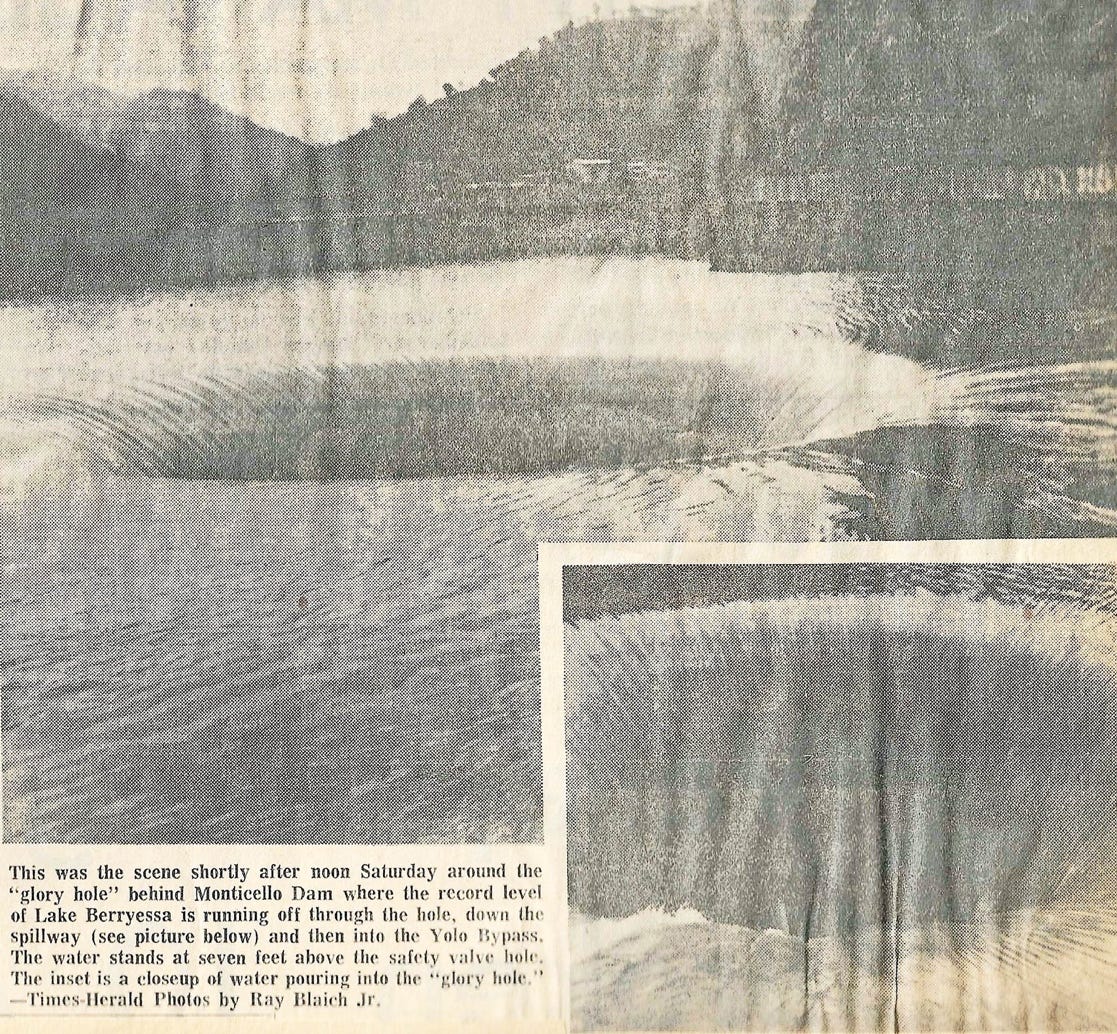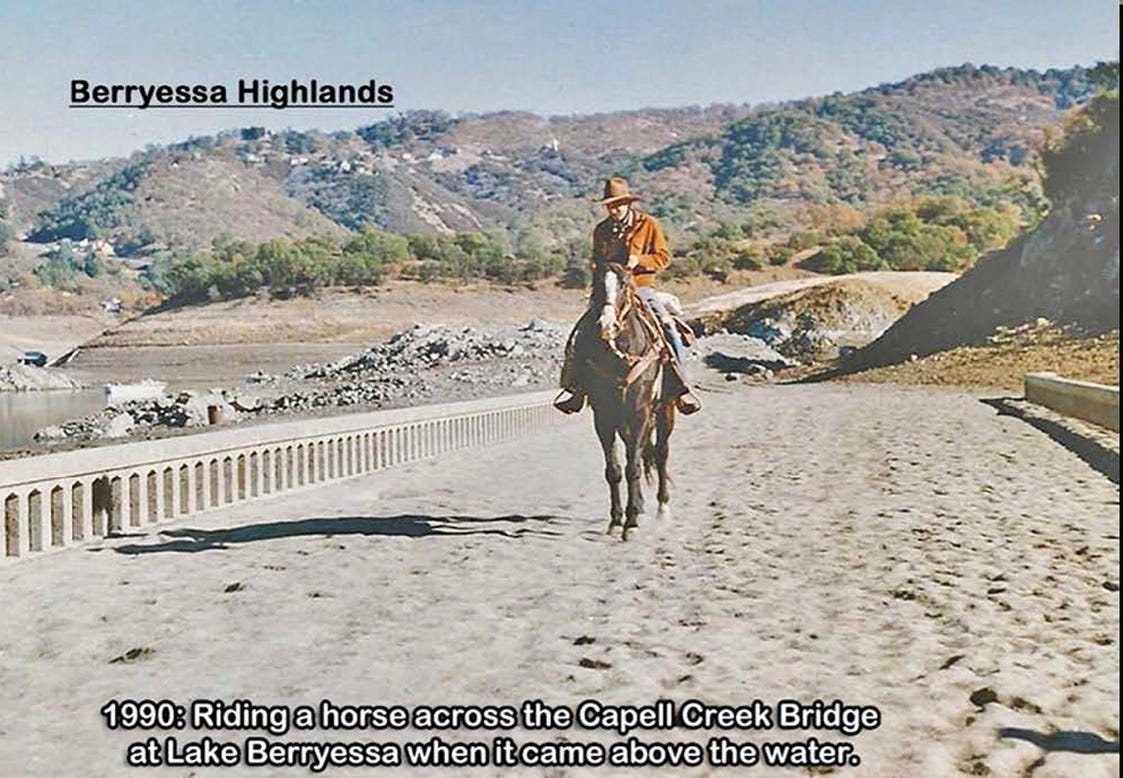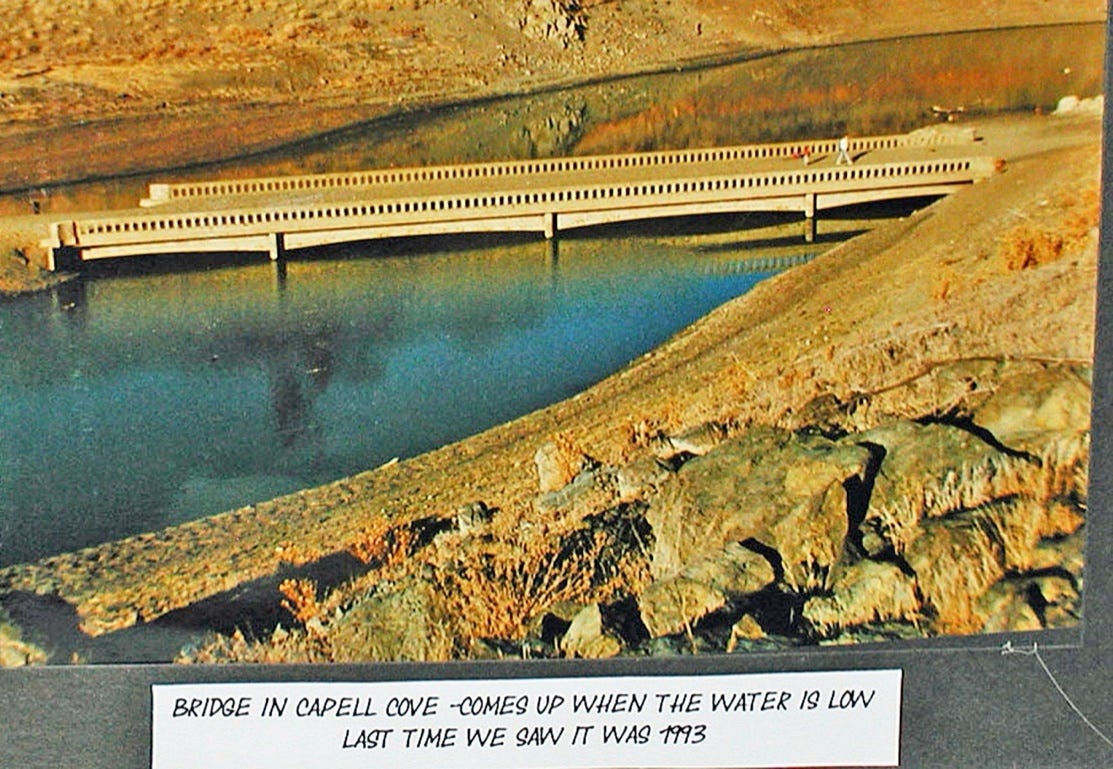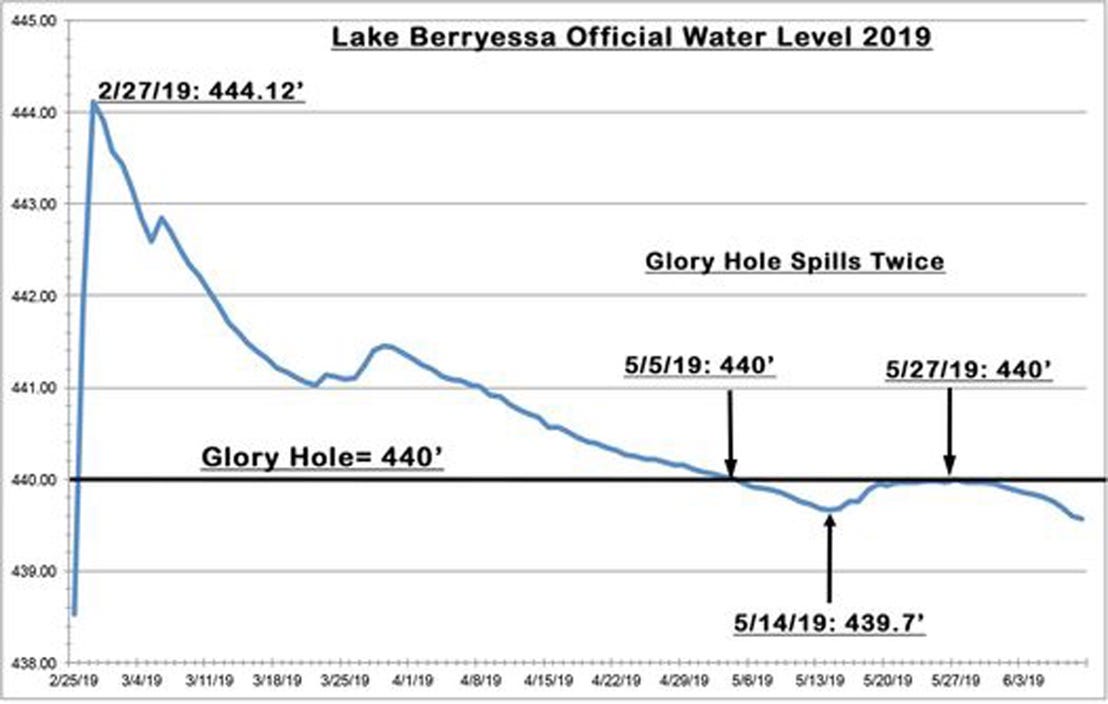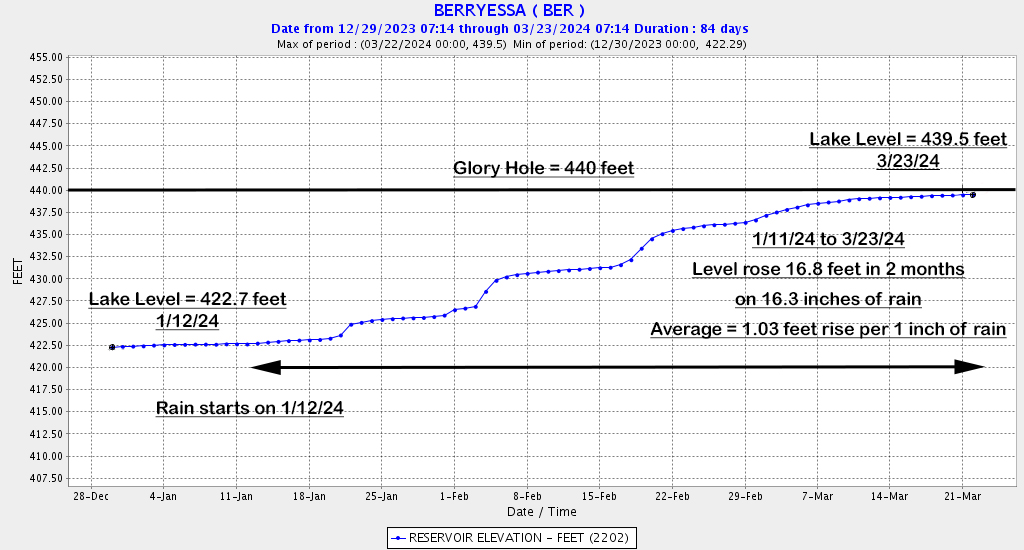NAPA, Calif. — In a previous Napa Valley Features article, Lake Berryessa: Glory Hole watch 2024, I described the basic structure and operation of Lake Berryessa's Monticello Dam and its internationally famous Glory Hole - 62 million views on YouTube. But Glory Hole has not overflowed yet this year. As of March 26, the lake level has only reached 439.6 feet, a frustrating 5 inches below the rim.
An asymptote is a mathematical value that continually approaches a given target value (like the 440 foot water level at which Lake Berryessa's Glory Hole officially overflows), but does not meet it at any finite distance. Watching the lake rise during the last few weeks has been what can be characterized for some folks as "riding the asymptote." And many people who have been riding the excitement of the 2024 rapid rise in lake level to this point are now left in an emotional limbo. The final goal of seeing the lake level hit 440 feet and overflow into Glory Hole is a great example of the mathematical concept of an asymptote.
Philosophically, this also illustrates the emotional impact of mathematics on the human psyche. The drama of the rise in lake levels is compelling and has the added the psychological value of making people feel connected to the lake. As the water approaches the lip asymptotically, so does the desire to see it overflow. But we all may be hoping for a miracle.
The Glory Hole may cause fear or awe in some observers, but it seems quite compelling at a subconscious level. Based on the thousands of hits on the Lake Berryessa News website and Facebook page responses to the daily updates, it is again an emotional roller coaster for some, as it was in 2017. Fly down into Glory Hole yourself in this mesmerizing video. How does it make you feel?

Not a whirlpool
Many news stories and social media posts describe the Glory Hole flow as a whirlpool or vortex that can "suck" the unwary into its dark depths. This is not a valid scientific description. The Bureau of Reclamation is concerned with the effect of vortices on dam structures since vortices consist of high-energy water movement that can erode output pipes and concrete channels. The mathematics of vortices and actual experiments on models of drain types at dams have shown that Lake Berryessa’s Glory Hole could not form a whirlpool (vortex) until the lake water level reaches 10 to 15 feet above the top of the dam.
Weather and climate variability are major scientific topics at present. However, the Bureau of Reclamation points out that they don't build dams that can overflow or fail. Can Lake Berryessa flood over the dam?
Conservation of mass
In the “science is fun” category, as a circular waterfall with smooth laminar flow in the middle of Lake Berryessa, the water entering the top of Glory Hole should be consistently smooth. But the photo below shows a small area of turbulence on the Highway 128 side of the structure. This is the result of the basic fluid dynamics law of conservation of mass, which dictates that the total mass entering the control volume must equal the total mass exiting the control volume. But the actual area of surface water feeding Glory Hole is constrained by the spillway's proximity to Highway 128. This requires the water on that side of the spillway to move more quickly to conform to the conservation of mass law. Thus, the water flow separates from the concrete interior sooner than the rest of the rim, causing earlier turbulence that shows up as a white-water anomaly closer to the rim.
In the 2019 photo below you can actually see the curving flow lines in the water's surface.
But what about the lowest of the high and the highest of the low?
People often like to celebrate record achievements such as the highest and the lowest of some arcane subject. For example, the highest recorded Lake Berryessa water level occurred in 1983, when the lake reached 446.7 feet, 6.7 feet above Glory Hole at 107% of capacity. I've never found a good photo of that event, but a longtime lake visitor sent me a scan of a newspaper clipping of an article from the 1983 Vallejo Times-Herald.
The lowest recorded Lake Berryessa water level occurred in January 1993 at 361.75 feet, 78.25 feet below Glory Hole at 26% capacity (421,530 acre-feet). I have not found any good photos of Glory Hole at that lowest level, but there are some illustrative photos of the Capell Creek Bridge from that time.
The Other Sunken Bridge: Capell Creek Bridge
Setting a new record?
The year 2024 may mark a new type of Glory Hole record. Will it be the highest level in history the lake has reached without flowing into Glory Hole? Historical data is sporadic before 1990, but what does exist appears to suggest that if the water gets as high as the spillway, it will usually go over. Data searches for the level of the annual peaks indicate that the lake has never reached this close to the top before without spilling. After reviewing all the available data, it seems 2024 may be a special year because it will be the closest the lake has gotten to the top of Glory Hole without going over — if it doesn't.
Sensor Plots for Lake Berryessa Data
But what about the lowest level recorded above the spillway once it has overflowed? The specific data on lake levels show that historically the level above Glory Hole is usually only a foot or less. For example, in 1999, 1 foot over; 2000, 0.3 foot over; 2003, 0.4 foot over; 2004, 2 feet over; 2005, 1.5 feet over. In 2019 the lake officially went over Glory Hole twice. Should the second time be considered a lowest of the high or a highest of the low?
The famous rule of thumb
Most of us have heard of the rule of thumb that Lake Berryessa rises 1 foot for every 1 inch of rain. As with most rules of thumb, this is not completely accurate. Lake-level rise depends on many variables, such as the actual lake level when it rains and how saturated the ground is. It usually takes about 3 inches of rain on dry hills before there is any appreciable runoff into the lake. Also, the lake is roughly like a V-shaped bowl. Picture a funnel, so the higher the level to start, the more rain it takes to make the lake rise even farther.
However, the chart above shows current data that show a lake-level rise of 12 inches per inch of rain so far for 2024. A look at actual data showed that the average increase in 2009, a drought year, was a 3.4-inch rise per inch of rain. In 2010 the number was a 7.5-inch rise per inch of rain. In 2011, that figure went from a 3-inch rise per inch of rainfall in early February to an 11-inch rise per inch in early March to a peak of 13 to 16 inches rise per inch during the wettest part of late March. The variability of natural systems, like the weather, can be breathtaking.
So, with only 5 inches to go, how much rain will we need? Unknown. Unfortunately, the ground has dried out considerably and the grass is growing wildly, quickly sucking up any rain that falls on it.
How many times has Glory Hole been breached?
By 2024 Glory Hole has overflowed only 27 times in the 67 years since the dam was finished in 1958. It took five years for the lake to first fill above the Glory Hole level. But has there ever been a year like 2024, when the level has gotten so close to the top but not flowed over the lip naturally, not due to wind or wakeboard boats? 2/12/17: Lake Berryessa Splashes Over Glory Hole -With a Little Help (No one tried boats in 2024 due to concerns about damaging the 70-foot-long temperature sensor string hanging down from the floating box you can see in the video and in person just behind the dam.)
The published data define the surface area of Lake Berryessa when it is at a lake level of 440 feet msl (the Glory Hole spillway height) as 20,700 acres with a total volume of 1,602,000 acre-feet. However, the worldwide attention focused on Lake Berryessa’s Glory Hole Spillway overflowing in 2017 for the first time in a decade raised some questions about these numbers from sharp-eyed Lake Berryessa News readers.
Using the published standard capacity of 1,602,000 acre-feet, these observers noticed that as the level approached the 440-foot mark (100%), the reported capacity was less than that published figure. In fact, at 440 feet (100%) the official storage value was only 96.2% of capacity — a 3.8% discrepancy. This new lake capacity was officially adopted by Reclamation and SCWA in 2009. The new curve has a lake capacity of 1,551,292 AF at a level of 440 feet — 50,708 AF less than previously calculated.
How Deep is Lake Berryessa?
Some people complain that too much water is being released from the dam or the lake would have overflowed Glory Hole already. But that's not accurate in that a minimum of 45 cubic feet per second (89 acre-feet per day, 448 gallons per minute) must be released by law and contract to protect the downstream Lower Putah Creek fishery and provide drinking water to 500,000 people in Solano County.
Also, that comment ignores the huge volume of water contained in the lake. The lake has a surface area of approximately 20,700 acres. The top 1 foot of the lake thus has 20,500 acre-feet of water. At the lowest rate of 45 cubic feet per second (89 acre-feet per day) it would take about 225 days for the lake to drop 1 foot. At the maximum rate during the summer, averaging 650 cubic feet per second (1,288 acre-feet per day), it would take 16 days to drop 1 foot, which is what we normally experience during the summer, with the addition of almost a foot of loss per month due to evaporation.
The rising lake before Glory Hole
It took five years after the dam was completed for the lake level to reach the top of Glory Hole. Lake Berryessa filled and spilled for the first time on the night of April 18, 1963.
But before there was a Glory Hole, the half-built Monticello Dam was hit by a heavy rain year in 1955 and was overtopped, with significant damage to the construction equipment although the dam itself was not harmed.
What's next?
Lake Berryessa water levels historically have had high variability, usually 15 to 20 feet differential annually, with an 85-foot maximum range in its 67-year history. This was one of the reasons the original dam builders never thought that Lake Berryessa would become a tourist destination. That was a serious failure of prognostication.
But uncertainties in future climate effects are of serious concern, especially as they affect water availability. The past long-term variability of Lake Berryessa water levels cannot be ascribed to global climate change. At one time my physics colleagues were studying potential global-cooling issues. Global cooling was a conjecture, especially during the 1970s, of imminent cooling of the earth due to the effects of aerosols or orbital forcing. That hypothesis was found by intense research not to be the governing climate problem. Decades of careful new research now show that solar heat trapping atmospheric gases, such as carbon dioxide and methane, are the driving forces. This means that future climate impacts need to be monitored carefully in terms of prudent planning.
If today’s story captured your interest, explore these related articles:
Peter Kilkus: nearly two decades of hyper-local news reporting in Napa County
Facebook group warns Napa Valley commuters of traffic tie-ups + Sounds of summer
Calistoga's Old Faithful Geyser: from tourist trap to natural wonder
Peter Kilkus is a Napa-County based journalist who has owned and operated the Lake Berryessa News since 2009.









